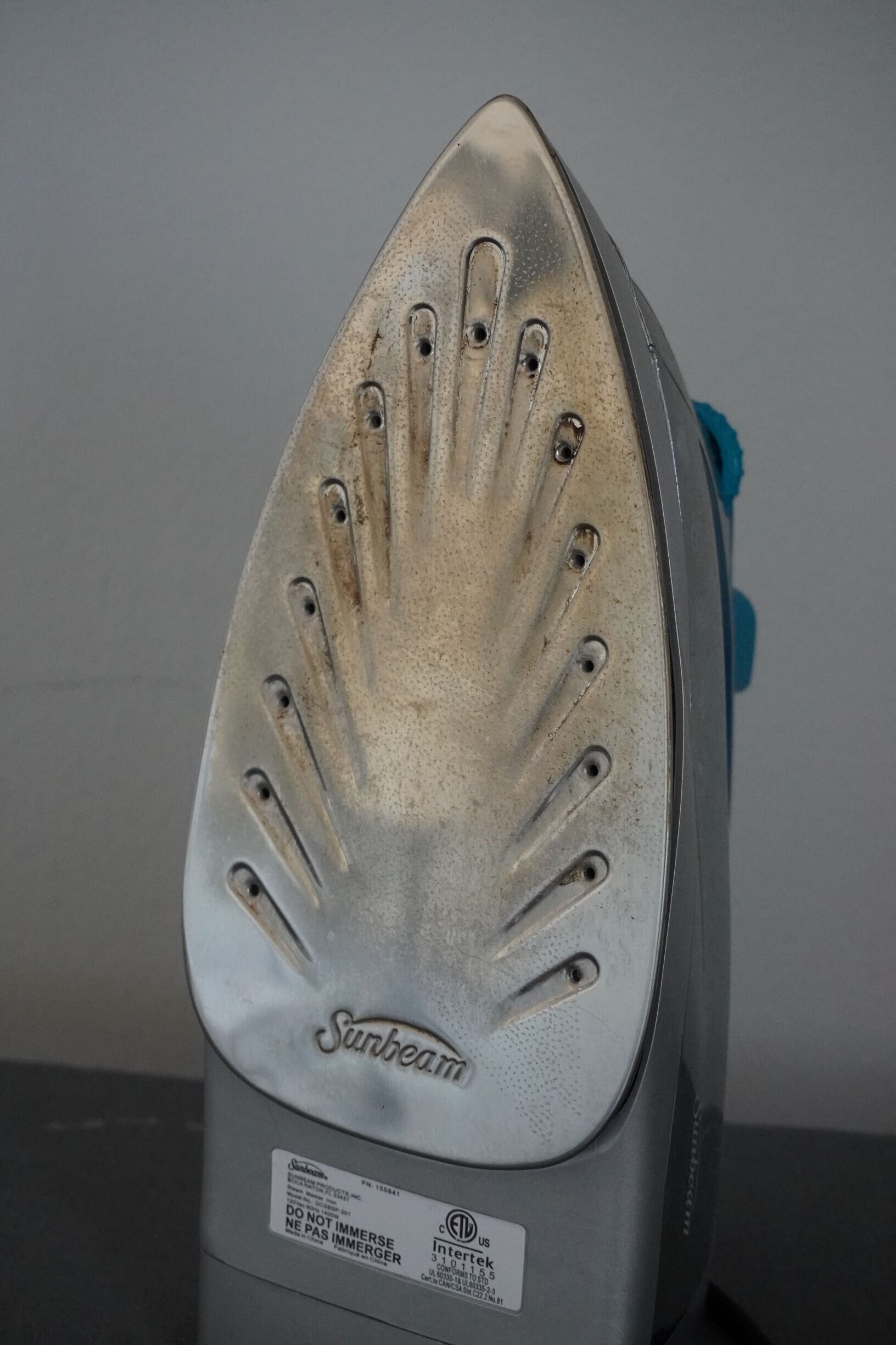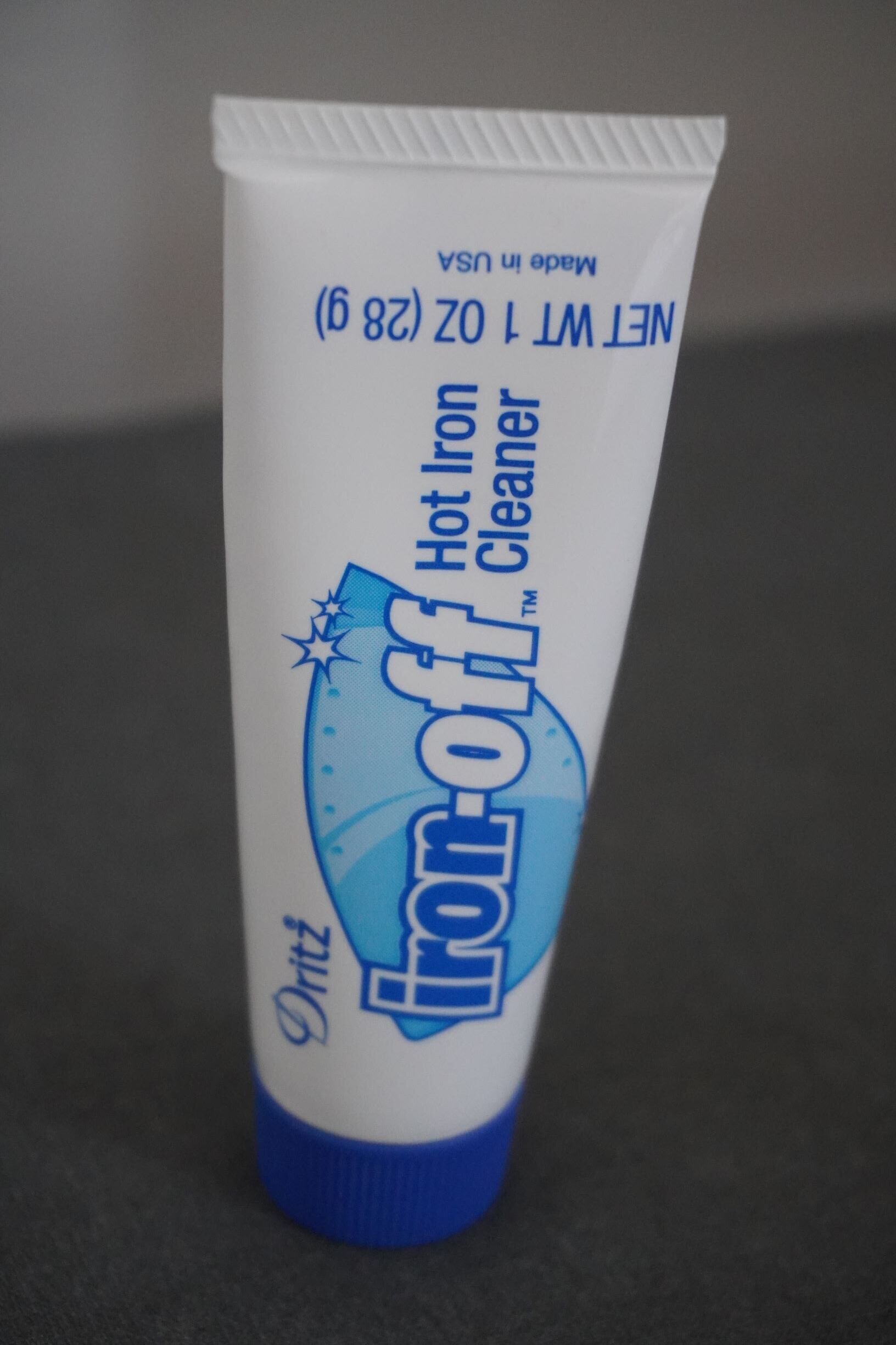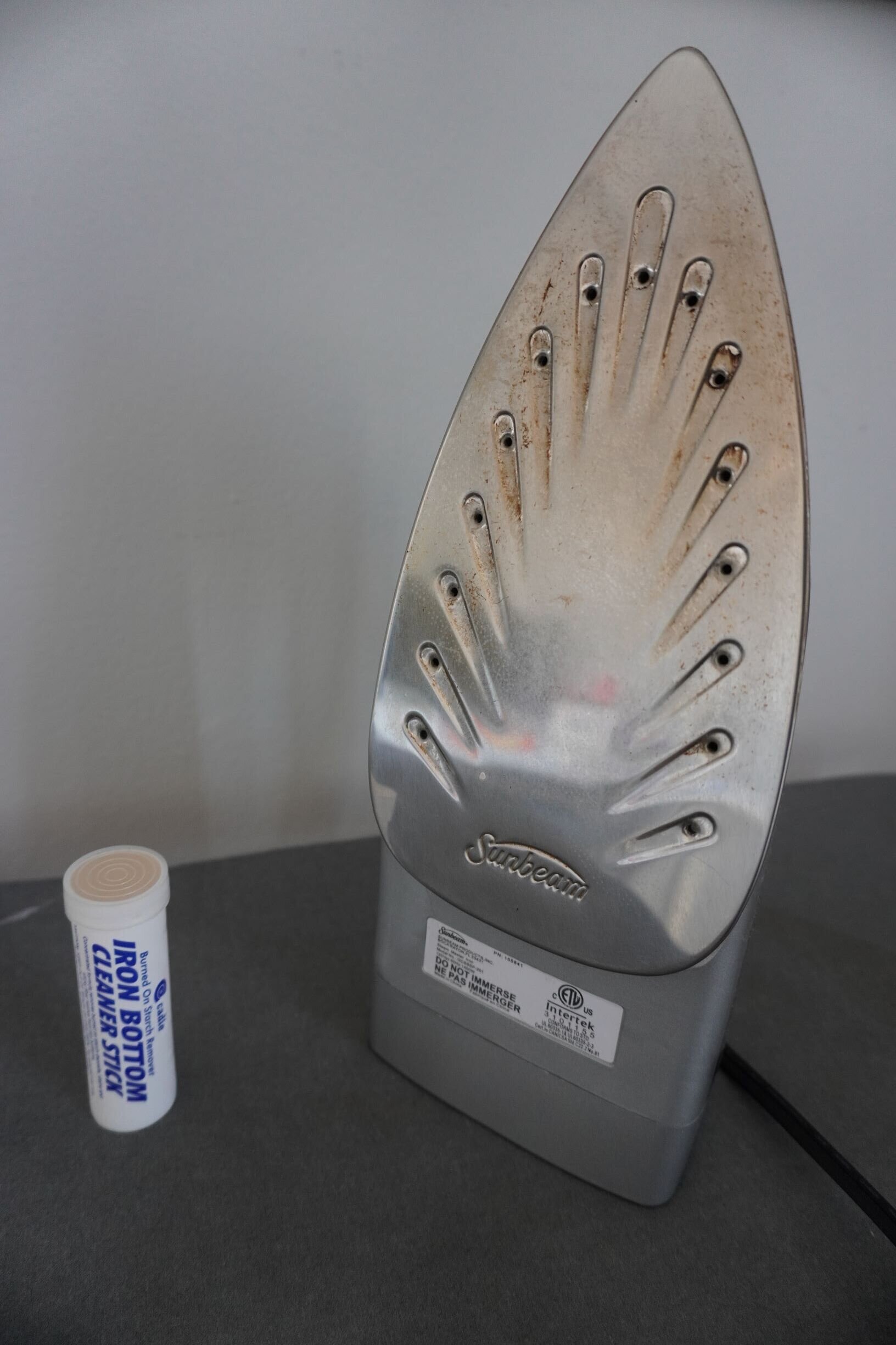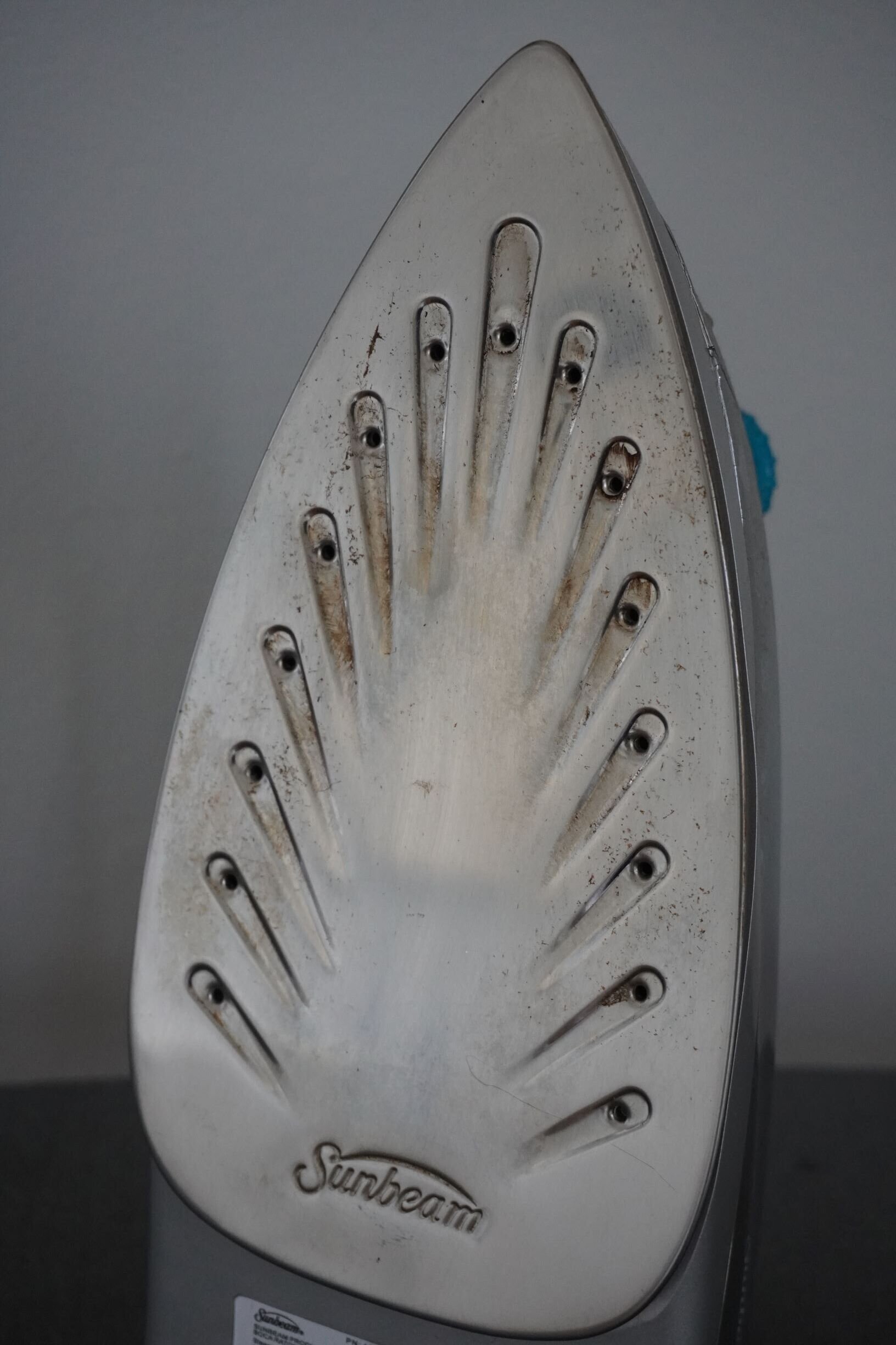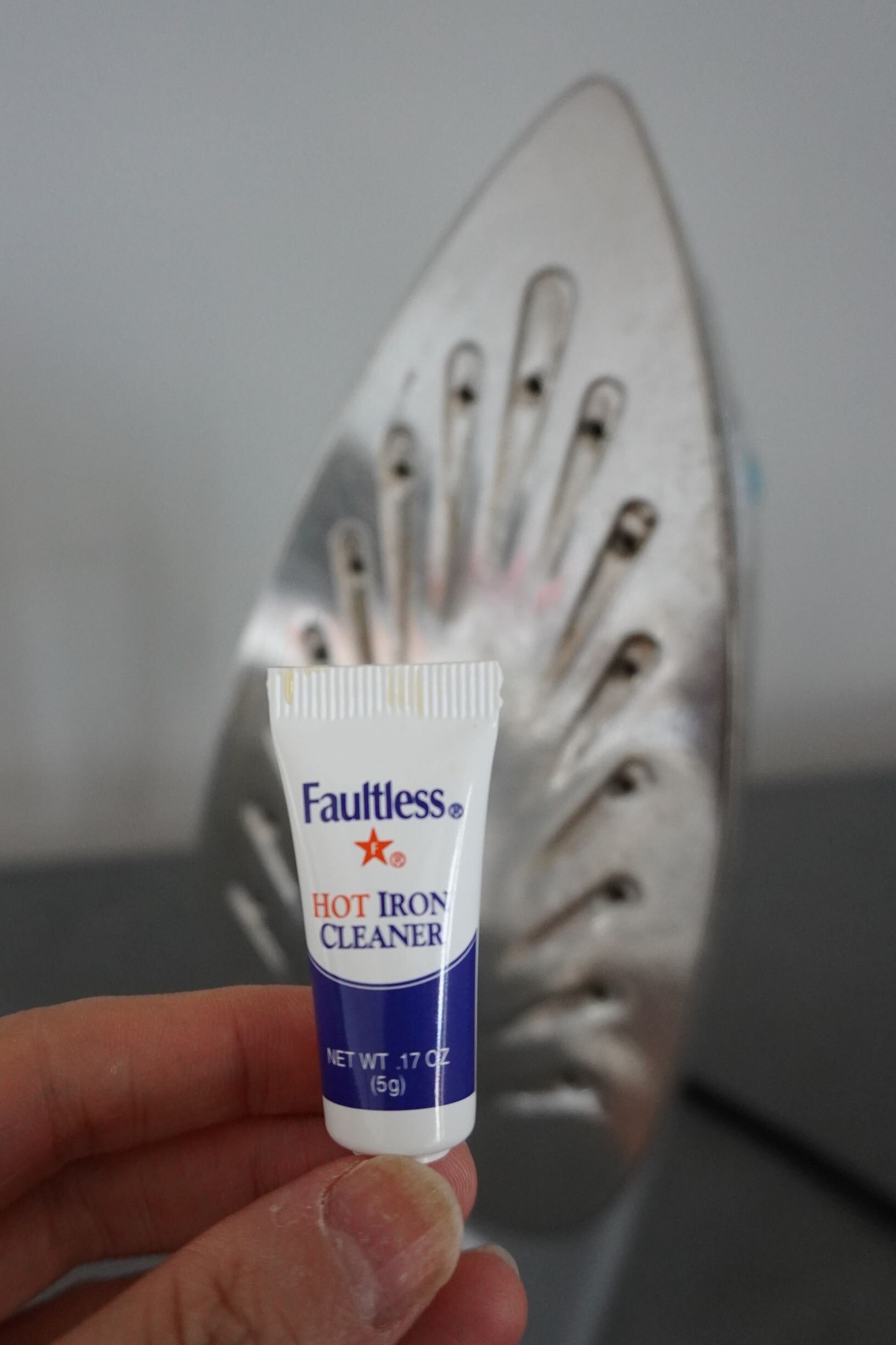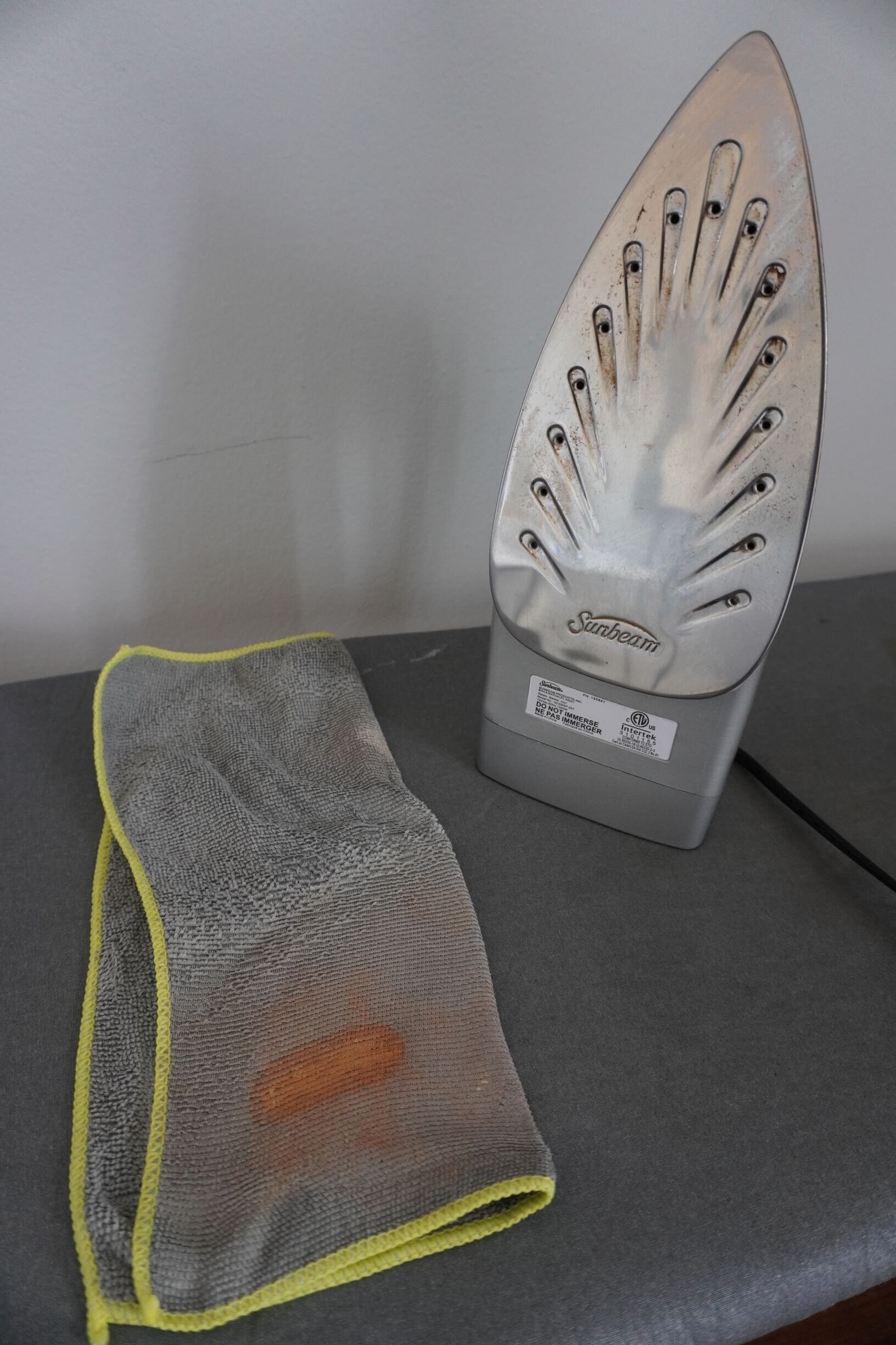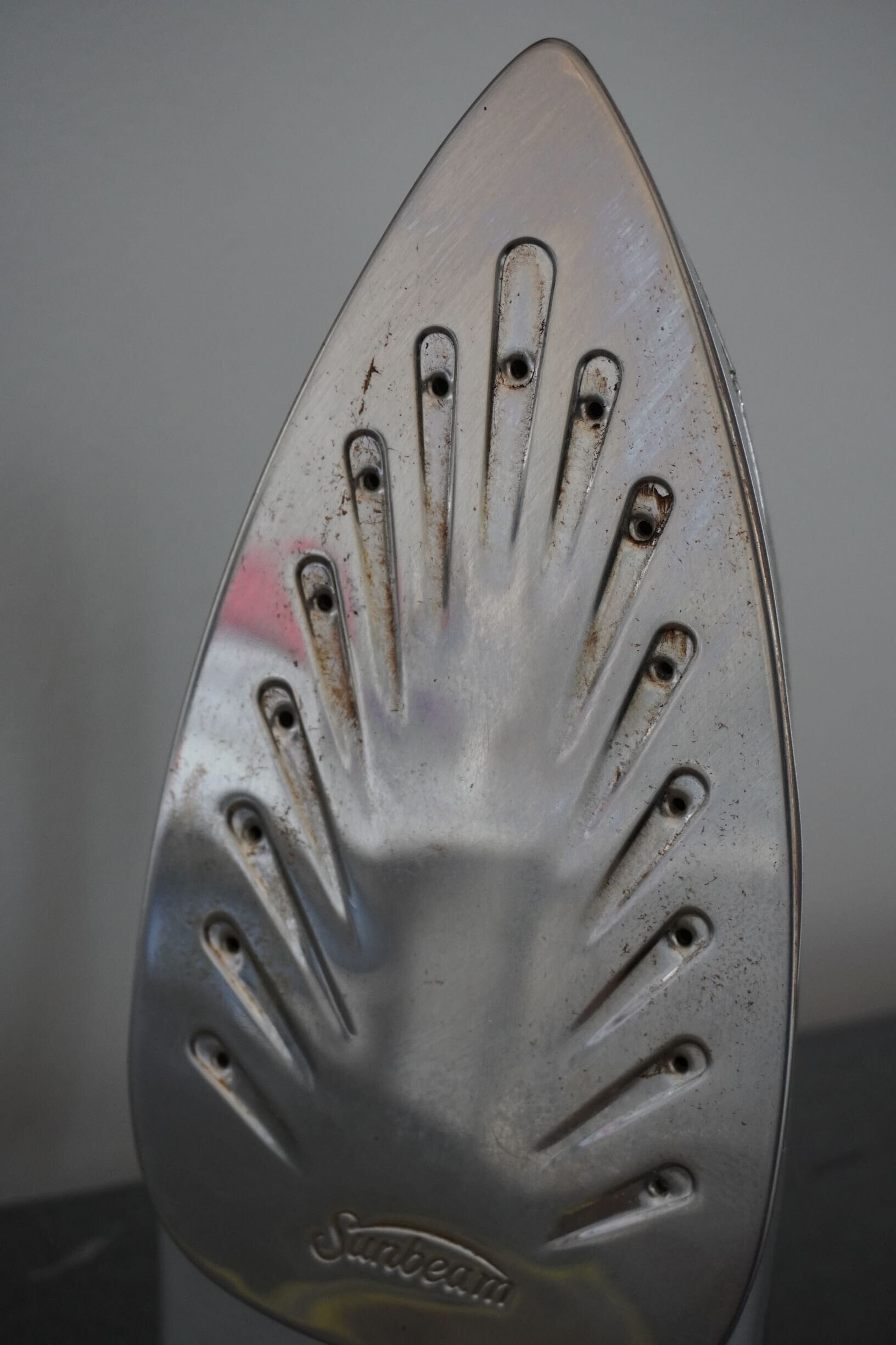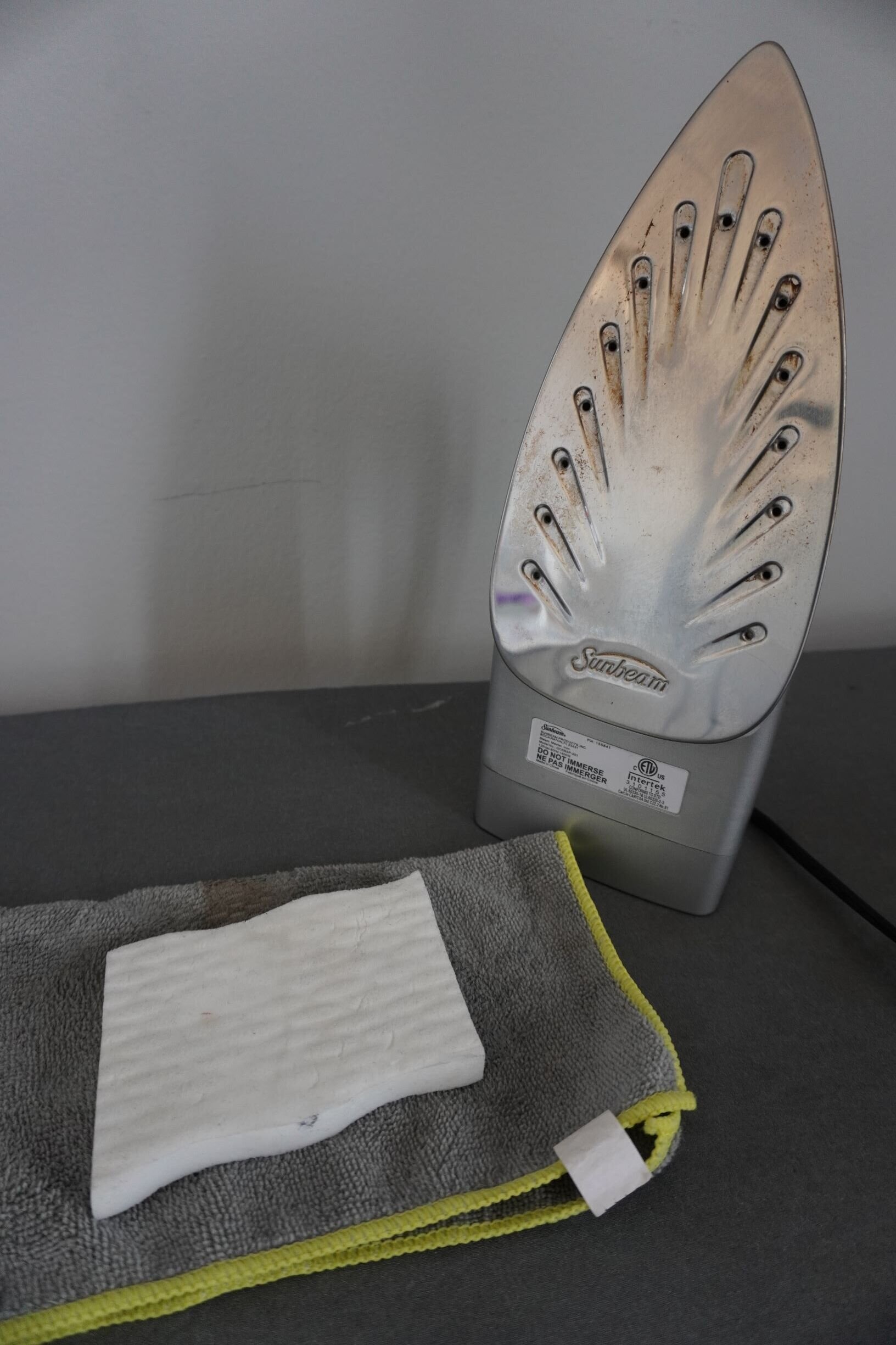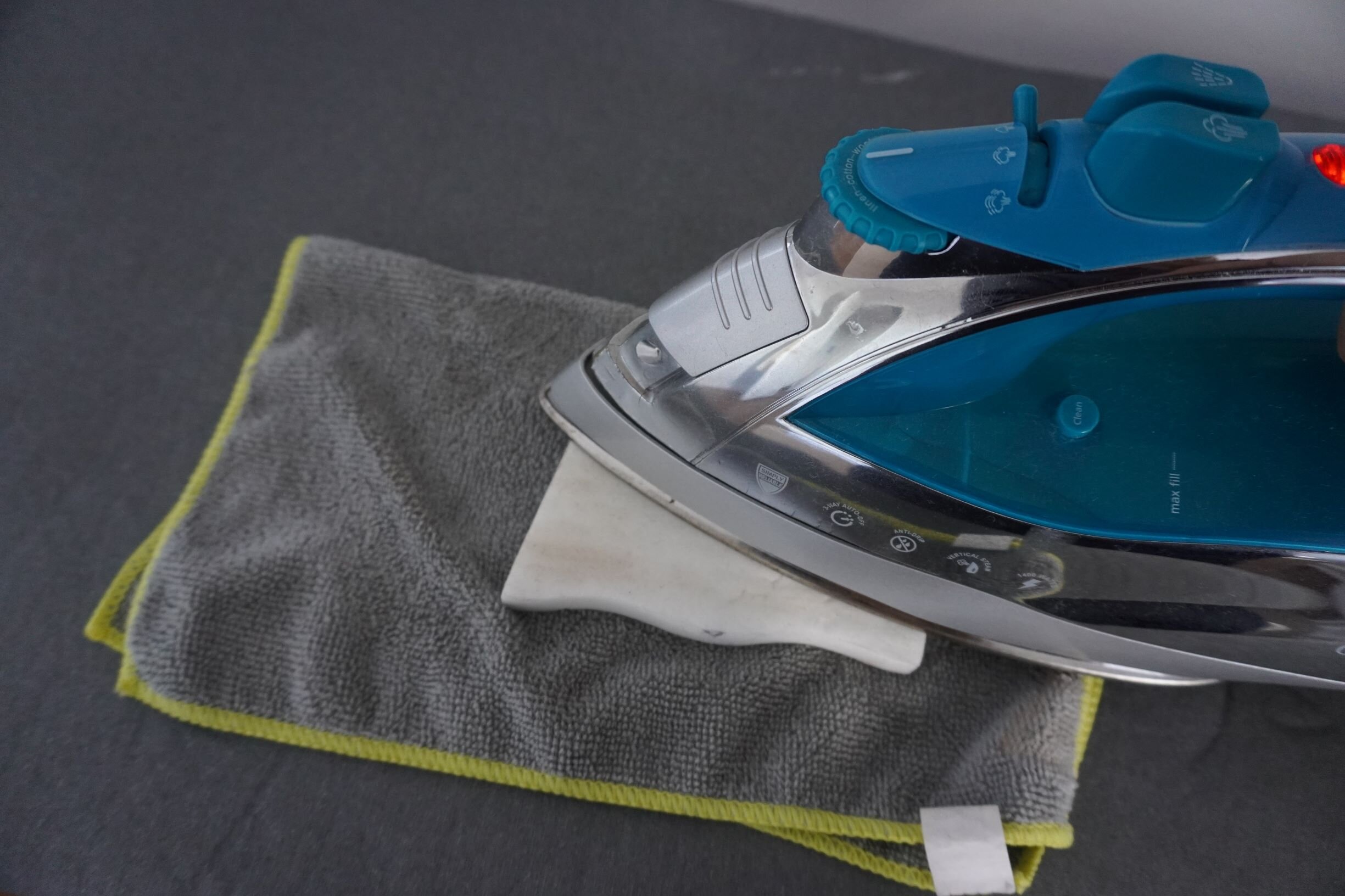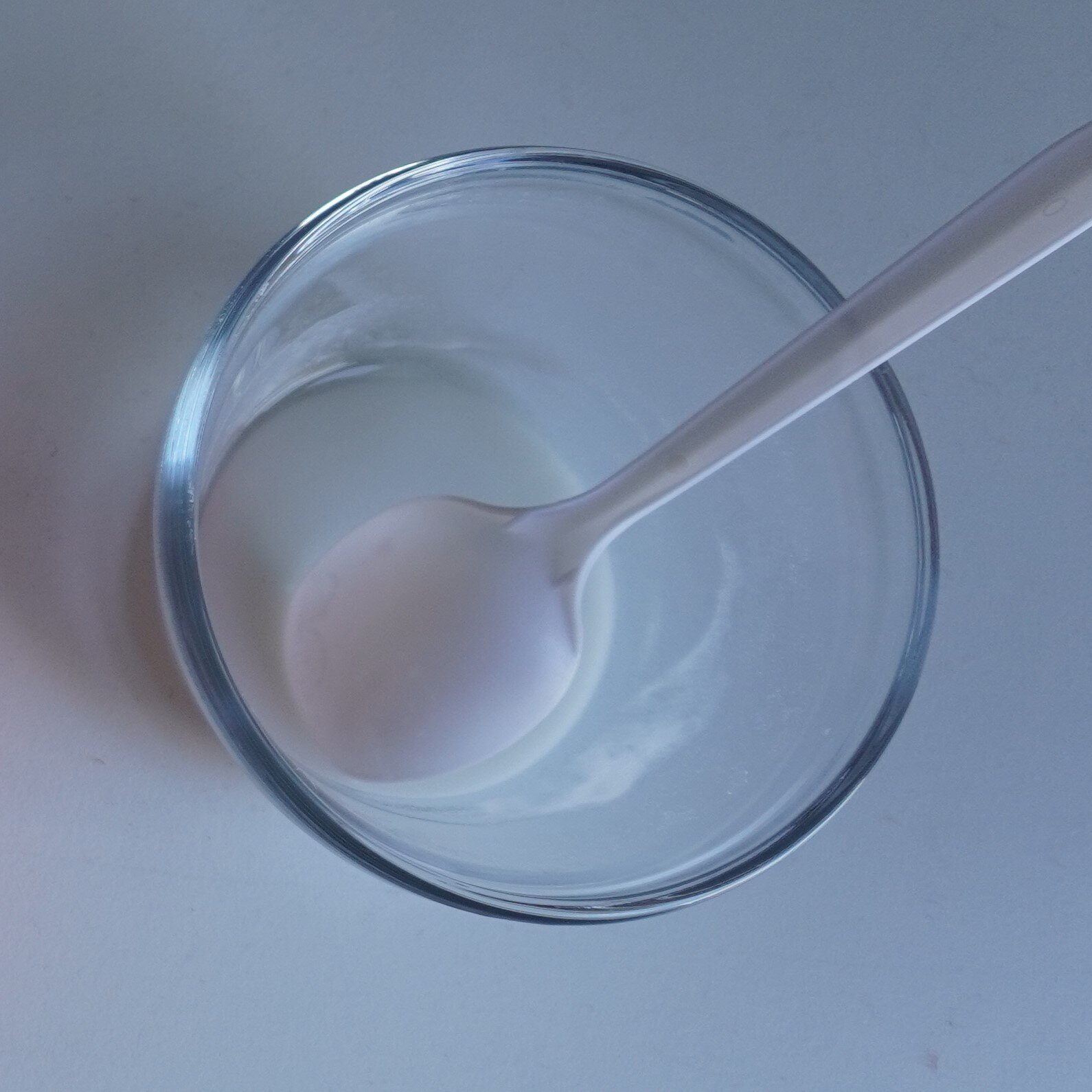One thing that will instantly elevate the quality of your finished garments is proper ironing. I never cared for ironing before I started sewing, but now that I sew most of my own clothes, I’ve become obsessed with properly ironing every seam, dart and edge of my projects. All that pressing can unfortunately lead to gunk building up on the hot plate of my iron, especially if you accidentally press your iron to the sticky side of interfacing. This gunk buildup eventually turns brown, which can then stain the precious fabric you are using in your sewing project.
So how do you clean that gunk off your iron? I tested six different methods for cleaning gunk off an iron, and the winner by far was Mr. Clean Magic Eraser, which was the only cleaning method that fully removed all of the gunk from the soleplate of the iron.
What kind of gunk builds up on irons?
Before I jump into the details of the test, a quick digression into the types of gunk that frequently build up on irons. For sewists, gunk on our irons usually comes from ironing the following products containing glue:
Fusible interfacing
Fusible fleece
Fusible web (like Stitch Witchery, Heat ‘n Bond and Wonder Under)
Hem tape (like Wundaweb)
Iron-on patches
Sewists may also get gunk buildup from:
Ironing fabric at too high of a heat setting
Ironing photo transfer paper
Melted plastic buttons or plastic heads on pins
I decided to test out different methods of removing the gunk buildup from all of these sources.
Setup of the test
I had the perfect subject for this test already built-in: an iron that had quite a lot of brown gunk caked on from probably over a year’s worth of sewing projects. I’m not sure exactly what this gunk consisted of, but my guess is it was a combination of glue from fusible interfacing and possibly some melted fabric from ironing fabrics at too high of a temperature.
To add to the gunk, I also intentionally (!) ironed the sticky side of some fusible interfacing before testing each cleaning method. That gave me a nice fresh coat of glue each time, so I could see if the cleaner removed it. Here’s a closeup of the long-term built-up gunk + freshly ironed fusible interfacing buildup on the soleplate of my iron:
I tested the following methods for cleaning the gunk of my iron:
Dryer sheet
Dritz Iron-Off
Cadie Iron Bottom Cleaner Stick
Faultless Iron Cleaner
Mr. Clean Magic Eraser
Baking soda + vinegar paste
I then followed the manufacturer’s instructions (or instructions found on the internet, in the case of the dryer sheet and baking soda + vinegar paste), and noted how effective the method was at removing both the freshly ironed fusible interfacing and the long-term built-up brown gunk. I also noted whether there were any downsides to the cleaning method.
Results of the test
Overall, I found that all of the cleaning methods were effective at removing the gunk from the freshy ironed fusible interfacing, but only the Magic Eraser was able to remove all of the long-term built-up brown gunk. Furthermore, the Magic Eraser was easy to use, didn’t emit any nauseating fumes and didn’t ruin my dish towels, unlike some of the other methods I tried. Below is a table summarizing the results of the test:
| Removed fresh fusible? | Removed long-term gunk buildup? | Downsides | |
|---|---|---|---|
| Dryer sheet | Yes | No | Gave off terrible fumes |
| Dritz Iron-Off | Yes | No | Ruined dish towels |
| Cadie iron bottom cleaner stick | Yes | Some | None |
| Faultless iron cleaner | Yes | Some | Ruined dish towels |
| Magic eraser | Yes | Yes | None |
| Baking soda + vinegar paste | ? | ? | Messy and time consuming |
I describe the results of each test (with accompanying photos) in more detail below.
Dryer Sheet
This method was touted in the sewing forums as a quick and easy way to remove fusible interfacing from your iron, but I found it only achieved middling results in my test. As instructed by the internet, I set my iron to a low heat setting, then passed the iron over the dryer sheet. This method worked for removing the freshly ironed fusible interfacing, but it didn’t remove the long-term built-up brown gunk at all.
This method also has the serious side effect of releasing some really terrible-smelling fumes. I don’t know much about the science of dryer sheets, but I have read that dryer sheets are coated with fabric softeners that are released when heated in the dryer. I suspect that when I ironed the dryer sheet, the heat from the iron released the chemicals in the fabric softener, which promptly went up my nose because I was hunched over the iron. This might be why some commenters in the sewing forums recommended using used, unscented dryer sheets, as those sheets are likely to have fewer chemicals and fragrances.
Dritz Iron-Off
The instructions direct you to set your iron to the “cotton” setting, apply a small amount of Iron-Off to a thickly folded cloth, then rub the hot iron over the cloth. I diligently followed these instructions, and I was able to remove the freshly ironed fusible interfacing, but I just could not remove the long-term built-up brown gunk. I even repeated the process several times thinking that would do the trick - I applied more Iron-Off, wiped again, and repeated the process at least three times, but even after all that, the brown gunk was still on my iron plate! Worst of all, the Iron-Off ended up ruining my dish towels, as the fibers of the towels became caked with Iron-Off, and the product stayed on my towels even after washing them in the washing machine (the pic below is of the dish towel after washing - the brown patches are where the Iron-Off product was applied to the dish towel).
Cadie Iron Bottom Cleaner Stick
The instructions direct you to rub the iron bottom cleaner stick onto the bottom of the iron while it is still warm, then let the iron cool and wipe away the residue with a cloth. The cleaner was easy to apply and easy to remove, and it did remove the freshly ironed fusible interfacing as well as some of the long-term built-up brown gunk (but definitely not all). It also left no residue on my dish towels, which was a relief as I didn’t have that many dish towels left after the Iron-Off fiasco.
I should also note that I’ve used other iron cleaner sticks in the past from different brands (though I can’t remember the brand names right now) and had similar experiences - they are easy to use but they don’t fully remove the really caked-on gunk.
Faultless Iron Cleaner
I have seen this product touted in several sewing forums as a miracle iron cleaning product, but I found that this product did not work any better than the other iron cleaning products. The instructions direct you to set your iron to the “cotton” setting, squeeze about two inches of Iron Cleaner to a towel, then rub the iron over the towel. The application method was very similar to Dritz Iron-Off, and perhaps unsurprisingly, the results were very similar as well: the Faultless Iron Cleaner was able to remove the freshly ironed fusible interfacing and a bit of the long-term built-up brown gunk, but there was still quite a lot of the built-up brown gunk remaining on the soleplate, particularly the brown gunk that was in the depressed area around the steam vents. The Iron Cleaner also ruined my dish towel, as the product is caked onto the fibers of the towel and I suspect it will not come off even after washing.
Magic Eraser
I have seen Mr. Clean Magic Eraser work wonders on removing stains from white tabletops, so I had high hopes that it would work to remove the gunk on my iron as well. I set the iron on a high heat setting, dampened the Magic Eraser, placed it on top of a folded towel and then passed the iron over the Magic Eraser several times. Lo and behold: it not only removed the freshly ironed fusible interfacing, but it also removed much of the long-term built-up brown gunk! After passing the iron over the Magic Eraser several times, I switched tactics and picked up the Magic Eraser to scrub the soleplate directly. This allowed me to really get into the depressed areas around the steam vents, and eventually I was rewarded by a sparkling clean soleplate that was completely gunk-free. (I finished the process off by ironing a spare piece of cotton muslin just to make sure that any residue from the Magic Eraser was removed.) This product was far and away the most effective product I tried, and there were no downsides like ruined dish towels or noxious fumes.
Baking Soda + Vinegar Paste
For some reason, there are a ton of websites out there recommending that you use a mixture of vinegar and baking soda to remove the gunk from your soleplate. To be honest, I didn’t get to test this method because the Magic Eraser left my iron sparkling clean so there was no gunk left to remove by the time I got to this cleaning method. However, just from a common sense point of view, using baking soda and vinegar seems like a really messy and time-consuming way to do things - you have to unplug your iron, let it cool down, make the vinegar/baking soda mixture, apply it to the soleplate and scrub with an old brush, then wipe it all off and plug your iron in again. No thank you. The Magic Eraser is much, much easier, and it won’t interrupt your sewing project - you can quickly wipe the gunk off your iron even while it is hot, and get back to your sewing project in less than five minutes.
Conclusion
The results of my test are clear and unequivocal: Magic Eraser is by far the best choice for removing long-term gunk buildup. Having said that, I could see keeping a used dryer sheet laying around my ironing board, so I can quickly remove the freshly ironed fusible interfacing the next time I accidentally iron the sticky side of my interfacing.
Do I need to do anything else to clean my iron?
In addition to cleaning the soleplate of my iron, I sometimes find that brown water starts spitting out of the steam vents of my iron, which can stain my fabric. When this happens, I know I need to clean the inside of my iron, and I do that following these steps:
Mix together half a cup of white vinegar with half a cup of water.
Pour the mixture into the reservoir of a cool, unplugged iron.
Plug the iron in and set it to steam; press the steam button several times until the steam flows out freely. Let the steam flow for a few minutes.
Unplug the iron and allow to cool, then empty out water and vinegar mixture.
Clear out the steam vents if there is residue blocking them. You can remove this gunk with a cotton bud or used toothbrush.
Do you agree or disagree with my findings? Let me know in the comments below!
